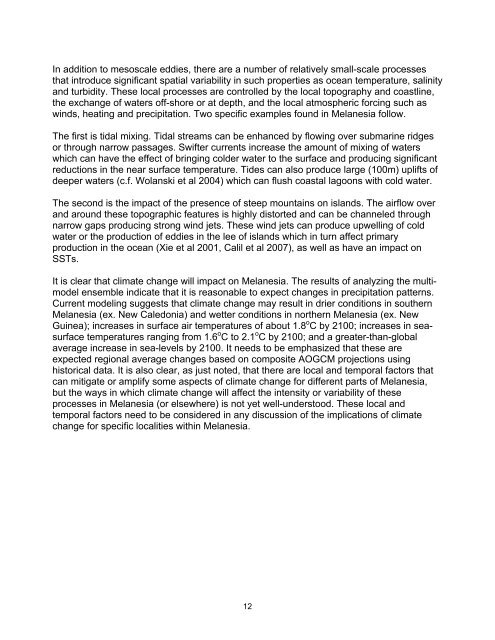What do we know? - Climate Adaptation Knowledge Exchange
What do we know? - Climate Adaptation Knowledge Exchange
What do we know? - Climate Adaptation Knowledge Exchange
- No tags were found...
Create successful ePaper yourself
Turn your PDF publications into a flip-book with our unique Google optimized e-Paper software.
In addition to mesoscale eddies, there are a number of relatively small-scale processesthat introduce significant spatial variability in such properties as ocean temperature, salinityand turbidity. These local processes are controlled by the local topography and coastline,the exchange of waters off-shore or at depth, and the local atmospheric forcing such aswinds, heating and precipitation. Two specific examples found in Melanesia follow.The first is tidal mixing. Tidal streams can be enhanced by flowing over submarine ridgesor through narrow passages. Swifter currents increase the amount of mixing of waterswhich can have the effect of bringing colder water to the surface and producing significantreductions in the near surface temperature. Tides can also produce large (100m) uplifts ofdeeper waters (c.f. Wolanski et al 2004) which can flush coastal lagoons with cold water.The second is the impact of the presence of steep mountains on islands. The airflow overand around these topographic features is highly distorted and can be channeled throughnarrow gaps producing strong wind jets. These wind jets can produce up<strong>we</strong>lling of coldwater or the production of eddies in the lee of islands which in turn affect primaryproduction in the ocean (Xie et al 2001, Calil et al 2007), as <strong>we</strong>ll as have an impact onSSTs.It is clear that climate change will impact on Melanesia. The results of analyzing the multimodelensemble indicate that it is reasonable to expect changes in precipitation patterns.Current modeling suggests that climate change may result in drier conditions in southernMelanesia (ex. New Cale<strong>do</strong>nia) and <strong>we</strong>tter conditions in northern Melanesia (ex. NewGuinea); increases in surface air temperatures of about 1.8 o C by 2100; increases in seasurfacetemperatures ranging from 1.6 o C to 2.1 o C by 2100; and a greater-than-globalaverage increase in sea-levels by 2100. It needs to be emphasized that these areexpected regional average changes based on composite AOGCM projections usinghistorical data. It is also clear, as just noted, that there are local and temporal factors thatcan mitigate or amplify some aspects of climate change for different parts of Melanesia,but the ways in which climate change will affect the intensity or variability of theseprocesses in Melanesia (or elsewhere) is not yet <strong>we</strong>ll-understood. These local andtemporal factors need to be considered in any discussion of the implications of climatechange for specific localities within Melanesia.12
















